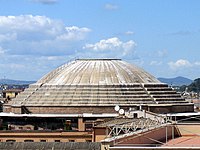
Photo from wikipedia
Abstract The construction industry and more particularly cement manufacture industry are European Green Deal strategic priorities for the circularity of Europe’s construction and demolition waste (CDW) stream with a view… Click to show full abstract
Abstract The construction industry and more particularly cement manufacture industry are European Green Deal strategic priorities for the circularity of Europe’s construction and demolition waste (CDW) stream with a view to reducing CO2 emissions. The industry is engaged in a number of strategies to that end, one of which is to manufacture new low-carbon, lower clinker/cement ratio cements by replacing portland clinker with inorganic fractions of CDW featuring hydraulic or pozzolanic properties. Against the backdrop of that global challenge, the present study explores the cementitious potential of the limestone and siliceous concrete fines and shatterproof building glass found in CDW as supplementary cementitious materials (SCMs) in new blended cements. The research was conducted in two stages: generation of new laboratory-scale knowledge; and industrial validation of the viability of using the highest volume waste streams. The laboratory-scale findings revealed that the presence of the filler effect and pozzolanicity in micronised inorganic fractions of concrete and building glass waste induces the neoformation of hydrated phases and C-S-H gel. Those two developments improve the short- and long-term physical and mechanical properties of the new blended cements at optimal replacement ratios of 5–7%. The order of material effectiveness in shortening setting times, increasing the heat of hydration and maintaining mechanical strength was observed to be as follows: limestone concrete > siliceous concrete > glass waste. Laboratory analysis was followed by a pilot study consisting in the manufacture of 184 t of blended cement in which 5% of the clinker was replaced by recycled concrete. Higher product performance than the commercial reference cement confirmed the industrial, technical, economic and environmental viability of the new product, estimated to hold potential for CO2 emissions abatement on the order of 41 kg CO2 eq./t of cement, which could translate into 80 Mt CO2 eq./year worldwide.
Journal Title: Construction and Building Materials
Year Published: 2021
Link to full text (if available)
Share on Social Media: Sign Up to like & get
recommendations!